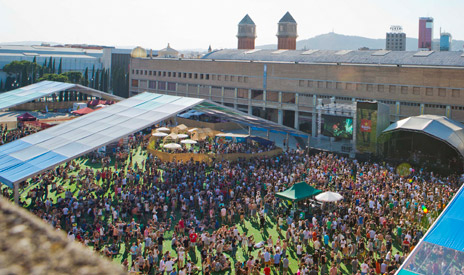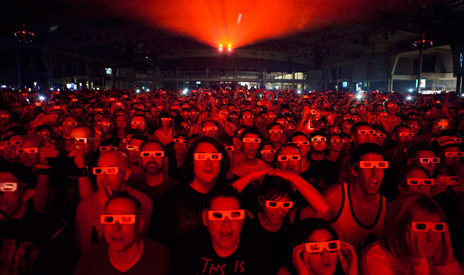- 121,000. That's about how many people attended Sónar this past weekend. Now in its 20th year, Sónar has grown considerably since it began in the '90s—it now sees a healthy portion of the worldwide electronic music community converge on Barcelona for a long weekend. With 100 acts spread across two venues (one daytime and one at night), it courts heads and mainstream dance fans alike.
Due to its continuing growth, Sónar By Day changed venues this year, moving to the larger Fira Montjuïc. The multi-purpose complex held four different stages, each with its own aesthetic. SónarVillage let punters bask in the beautiful Mediterranean weather, with as much space to lounge on the soft turf as there was to dance. The lineup was a mixture of pop-oriented live acts—from the deep disco of Chromatics to the sprightly beats of AlunaGeorge—and sunny-skies DJs. There was also room for Modeselektor, who played a very 50 Weapons DJ set, but not before giving Siriusmo a surprise 30-minute spotlight.
 The other stages offered a reprieve from the beaming sun, especially for those who prefer a nightclub vibe. The cavernous SónarHall hosted some of the weekend's best techno, especially Diamond Version, the collaborative project from Raster-Noton's Alva Noto and Byetone. Red Bull's upstairs SónarDome, complete with comfy lounge area, closed out with a memorable set from trap stars TNGHT, who flooded the space with artificial smoke and their own intense strobe lights.
If Sónar By Day felt big, then Sónar By Night was almost surreally massive. Taking over the Fira Gran Via L'Hospitalet, it was like the biggest warehouse rave you've ever been to—four times over (and with bumper cars). Kraftwerk gave a true headlining performance on Friday night, playing a two-hour greatest hits set that frequently broke out into what felt like straight-up techno. Accompanied by three-dimensional visuals (which meant 3D glasses were handed out to each and every reveler), tracks like "Trans-Europe Express" were rendered ominous, while "Autobahn" and especially "Tour De France" were greeted with enthusiasm from a crowd that seemed to know every song. They were followed by the playful US club stylings of Baauer, and later, Skrillex. It was a juxtaposition that highlighted the festival's dual nature, daring to mix the stadium-ready with more underground acts—Karenn and San Proper both played live next door.
The other stages offered a reprieve from the beaming sun, especially for those who prefer a nightclub vibe. The cavernous SónarHall hosted some of the weekend's best techno, especially Diamond Version, the collaborative project from Raster-Noton's Alva Noto and Byetone. Red Bull's upstairs SónarDome, complete with comfy lounge area, closed out with a memorable set from trap stars TNGHT, who flooded the space with artificial smoke and their own intense strobe lights.
If Sónar By Day felt big, then Sónar By Night was almost surreally massive. Taking over the Fira Gran Via L'Hospitalet, it was like the biggest warehouse rave you've ever been to—four times over (and with bumper cars). Kraftwerk gave a true headlining performance on Friday night, playing a two-hour greatest hits set that frequently broke out into what felt like straight-up techno. Accompanied by three-dimensional visuals (which meant 3D glasses were handed out to each and every reveler), tracks like "Trans-Europe Express" were rendered ominous, while "Autobahn" and especially "Tour De France" were greeted with enthusiasm from a crowd that seemed to know every song. They were followed by the playful US club stylings of Baauer, and later, Skrillex. It was a juxtaposition that highlighted the festival's dual nature, daring to mix the stadium-ready with more underground acts—Karenn and San Proper both played live next door.
 Though run exceedingly well for such a massive event—sets almost always ran on time, navigation was straightforward, and the soundsystems were solid if not fantastic—many of the gripes I'd heard ahead of the event rang true. Drinks (and even food), in addition to being expensive, could only be bought with tickets, which were sold at a different counter, meaning that any kind of refreshment required waiting in two lines. This was a hopeless endeavour amidst the thousands-strong crowd at Sónar By Night. And anything this big will always lack a vibe, trading atmosphere for size to create an event that's as inclusive as possible.
But Sónar do the rare job of mixing the underground and the mainstream, somehow making it appealing to both crowds. Two decades in, Sónar means different things to different people—especially those who have come to prefer the unrelated club events happening across Barcelona during the festival—but it clearly deserves its long-fought prominence as one of the world's premiere electronic music events.
Though run exceedingly well for such a massive event—sets almost always ran on time, navigation was straightforward, and the soundsystems were solid if not fantastic—many of the gripes I'd heard ahead of the event rang true. Drinks (and even food), in addition to being expensive, could only be bought with tickets, which were sold at a different counter, meaning that any kind of refreshment required waiting in two lines. This was a hopeless endeavour amidst the thousands-strong crowd at Sónar By Night. And anything this big will always lack a vibe, trading atmosphere for size to create an event that's as inclusive as possible.
But Sónar do the rare job of mixing the underground and the mainstream, somehow making it appealing to both crowds. Two decades in, Sónar means different things to different people—especially those who have come to prefer the unrelated club events happening across Barcelona during the festival—but it clearly deserves its long-fought prominence as one of the world's premiere electronic music events.
 The other stages offered a reprieve from the beaming sun, especially for those who prefer a nightclub vibe. The cavernous SónarHall hosted some of the weekend's best techno, especially Diamond Version, the collaborative project from Raster-Noton's Alva Noto and Byetone. Red Bull's upstairs SónarDome, complete with comfy lounge area, closed out with a memorable set from trap stars TNGHT, who flooded the space with artificial smoke and their own intense strobe lights.
If Sónar By Day felt big, then Sónar By Night was almost surreally massive. Taking over the Fira Gran Via L'Hospitalet, it was like the biggest warehouse rave you've ever been to—four times over (and with bumper cars). Kraftwerk gave a true headlining performance on Friday night, playing a two-hour greatest hits set that frequently broke out into what felt like straight-up techno. Accompanied by three-dimensional visuals (which meant 3D glasses were handed out to each and every reveler), tracks like "Trans-Europe Express" were rendered ominous, while "Autobahn" and especially "Tour De France" were greeted with enthusiasm from a crowd that seemed to know every song. They were followed by the playful US club stylings of Baauer, and later, Skrillex. It was a juxtaposition that highlighted the festival's dual nature, daring to mix the stadium-ready with more underground acts—Karenn and San Proper both played live next door.
The other stages offered a reprieve from the beaming sun, especially for those who prefer a nightclub vibe. The cavernous SónarHall hosted some of the weekend's best techno, especially Diamond Version, the collaborative project from Raster-Noton's Alva Noto and Byetone. Red Bull's upstairs SónarDome, complete with comfy lounge area, closed out with a memorable set from trap stars TNGHT, who flooded the space with artificial smoke and their own intense strobe lights.
If Sónar By Day felt big, then Sónar By Night was almost surreally massive. Taking over the Fira Gran Via L'Hospitalet, it was like the biggest warehouse rave you've ever been to—four times over (and with bumper cars). Kraftwerk gave a true headlining performance on Friday night, playing a two-hour greatest hits set that frequently broke out into what felt like straight-up techno. Accompanied by three-dimensional visuals (which meant 3D glasses were handed out to each and every reveler), tracks like "Trans-Europe Express" were rendered ominous, while "Autobahn" and especially "Tour De France" were greeted with enthusiasm from a crowd that seemed to know every song. They were followed by the playful US club stylings of Baauer, and later, Skrillex. It was a juxtaposition that highlighted the festival's dual nature, daring to mix the stadium-ready with more underground acts—Karenn and San Proper both played live next door.
 Though run exceedingly well for such a massive event—sets almost always ran on time, navigation was straightforward, and the soundsystems were solid if not fantastic—many of the gripes I'd heard ahead of the event rang true. Drinks (and even food), in addition to being expensive, could only be bought with tickets, which were sold at a different counter, meaning that any kind of refreshment required waiting in two lines. This was a hopeless endeavour amidst the thousands-strong crowd at Sónar By Night. And anything this big will always lack a vibe, trading atmosphere for size to create an event that's as inclusive as possible.
But Sónar do the rare job of mixing the underground and the mainstream, somehow making it appealing to both crowds. Two decades in, Sónar means different things to different people—especially those who have come to prefer the unrelated club events happening across Barcelona during the festival—but it clearly deserves its long-fought prominence as one of the world's premiere electronic music events.
Though run exceedingly well for such a massive event—sets almost always ran on time, navigation was straightforward, and the soundsystems were solid if not fantastic—many of the gripes I'd heard ahead of the event rang true. Drinks (and even food), in addition to being expensive, could only be bought with tickets, which were sold at a different counter, meaning that any kind of refreshment required waiting in two lines. This was a hopeless endeavour amidst the thousands-strong crowd at Sónar By Night. And anything this big will always lack a vibe, trading atmosphere for size to create an event that's as inclusive as possible.
But Sónar do the rare job of mixing the underground and the mainstream, somehow making it appealing to both crowds. Two decades in, Sónar means different things to different people—especially those who have come to prefer the unrelated club events happening across Barcelona during the festival—but it clearly deserves its long-fought prominence as one of the world's premiere electronic music events.